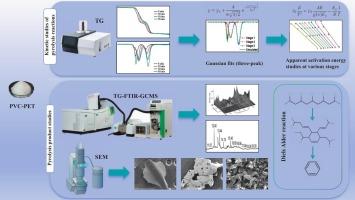Study on kinetics and products of co-pyrolysis of polyvinyl chloride and polyethylene terephthalate
IF 5.4
3区 工程技术
Q2 ENERGY & FUELS
引用次数: 0
Abstract
The production of plastic waste is increasing rapidly. Landfilling and incineration, as common recycling methods, are no longer sufficient to meet environmental protection requirements. Therefore, plastic pyrolysis has attracted widespread attention. Polyvinyl chloride (PVC) and polyethylene terephthalate (PET) are both typical components of waste plastics. Due to the overlap in their application fields, they often coexist in the collected waste plastics. Therefore, co-pyrolysis of PVC and PET plastics appears to be more valuable for research. This study was conducted based on thermogravimetric analysis (TG), Fourier transform infrared spectroscopy (FTIR), gas chromatography-mass spectrometry (GC–MS), and their combined techniques. It was found that when PVC and PET are mixed, the stage II of the pyrolysis reaction of PVC plastic is enhanced, and the yield of aromatic organic substances in stage II of the co-pyrolysis reaction of the mixed plastic significantly decreases. Due to the insufficient ability of the traditional KAS method in analyzing the kinetics of complex multi-step reactions, this study combines the mathematical method of Gaussian peak fitting with the KAS method, and fits the TG curve of plastic pyrolysis into a multi-stage reaction curve with peaks, and conducts independent analysis. Compared with single-component plastics, the average apparent activation energy of PVC-PET mixed plastics is lower, and there is a synergistic effect between the pyrolysis reactions of the two plastics. The energy demand of the mixed plastics co-pyrolysis reaction is more stable, which is conducive to the stable operation of the equipment in industrial production and reduces energy loss. And the solid product of PVC-PET co-pyrolysis has a loose texture that is not easily adhered to the surface of the pyrolysis reactor, effectively reducing the risk of equipment scorching.

聚氯乙烯与聚对苯二甲酸乙二醇酯共热解动力学及产物研究
塑料垃圾的产量正在迅速增加。堆填和焚化作为常见的回收方法,已不足以满足环保要求。因此,塑料热解引起了广泛的关注。聚氯乙烯(PVC)和聚对苯二甲酸乙二醇酯(PET)都是废塑料的典型成分。由于其应用领域的重叠性,在回收的废塑料中往往是共存的。因此,PVC和PET塑料的共热解就显得更有研究价值。本研究基于热重分析(TG)、傅里叶变换红外光谱(FTIR)、气相色谱-质谱(GC-MS)及其联合技术进行。研究发现,当PVC和PET混合时,PVC塑料的第二阶段热解反应增强,混合塑料的第二阶段共热解反应芳香族有机物产率显著降低。由于传统KAS方法分析复杂多步反应动力学的能力不足,本研究将高斯峰拟合的数学方法与KAS方法相结合,将塑料热解的TG曲线拟合为多段有峰反应曲线,并进行独立分析。与单组分塑料相比,PVC-PET混合塑料的平均表观活化能较低,两种塑料的热解反应之间存在协同效应。混合塑料共热解反应的能量需求更加稳定,有利于设备在工业生产中稳定运行,减少能量损失。并且PVC-PET共热解的固体产物质地疏松,不易粘附在热解反应器表面,有效降低设备烧焦的风险。
本文章由计算机程序翻译,如有差异,请以英文原文为准。
求助全文
约1分钟内获得全文
求助全文
来源期刊

Thermal Science and Engineering Progress
Chemical Engineering-Fluid Flow and Transfer Processes
CiteScore
7.20
自引率
10.40%
发文量
327
审稿时长
41 days
期刊介绍:
Thermal Science and Engineering Progress (TSEP) publishes original, high-quality research articles that span activities ranging from fundamental scientific research and discussion of the more controversial thermodynamic theories, to developments in thermal engineering that are in many instances examples of the way scientists and engineers are addressing the challenges facing a growing population – smart cities and global warming – maximising thermodynamic efficiencies and minimising all heat losses. It is intended that these will be of current relevance and interest to industry, academia and other practitioners. It is evident that many specialised journals in thermal and, to some extent, in fluid disciplines tend to focus on topics that can be classified as fundamental in nature, or are ‘applied’ and near-market. Thermal Science and Engineering Progress will bridge the gap between these two areas, allowing authors to make an easy choice, should they or a journal editor feel that their papers are ‘out of scope’ when considering other journals. The range of topics covered by Thermal Science and Engineering Progress addresses the rapid rate of development being made in thermal transfer processes as they affect traditional fields, and important growth in the topical research areas of aerospace, thermal biological and medical systems, electronics and nano-technologies, renewable energy systems, food production (including agriculture), and the need to minimise man-made thermal impacts on climate change. Review articles on appropriate topics for TSEP are encouraged, although until TSEP is fully established, these will be limited in number. Before submitting such articles, please contact one of the Editors, or a member of the Editorial Advisory Board with an outline of your proposal and your expertise in the area of your review.
 求助内容:
求助内容: 应助结果提醒方式:
应助结果提醒方式:


